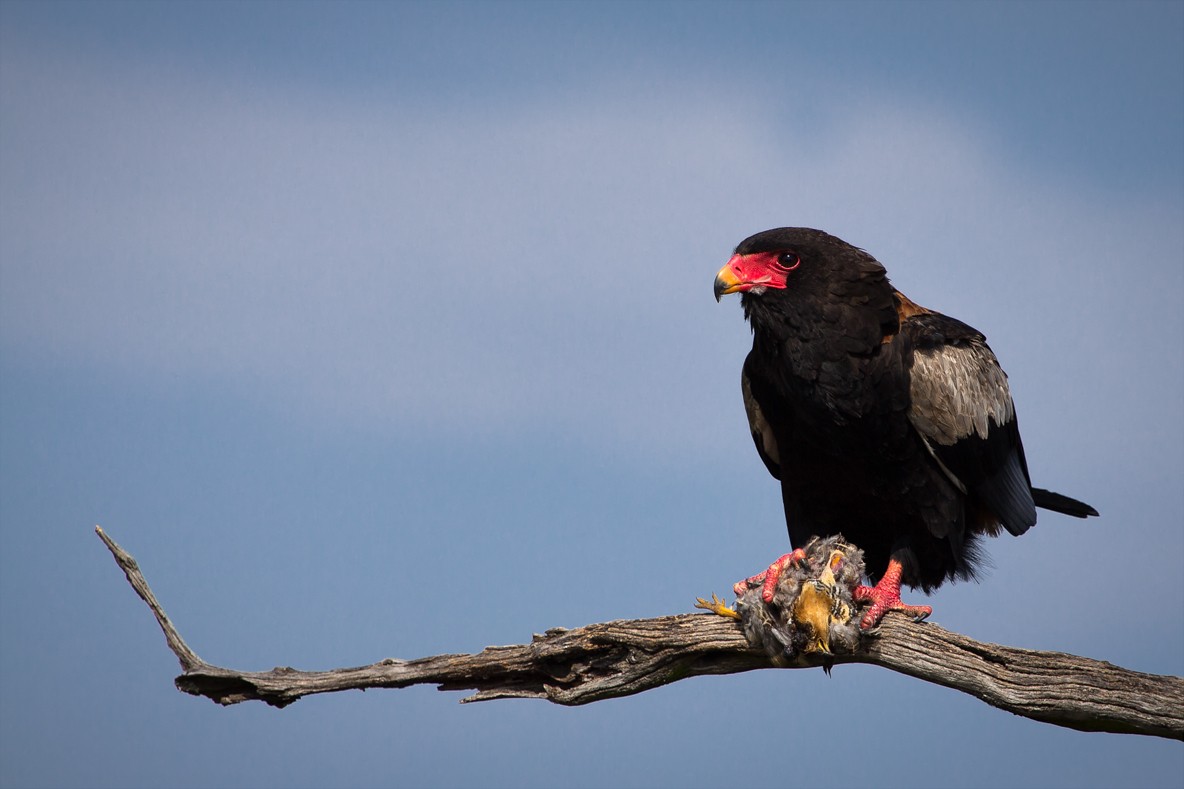Bateleur
A species of Bateleur Scientific name : Terathopius ecaudatus Genus : Bateleur
Bateleur, A species of Bateleur
Botanical name: Terathopius ecaudatus
Genus: Bateleur
Content
Description People often ask General Info
 Photo By Sumeet Moghe , used under CC-BY-SA-3.0 /Cropped and compressed from original
Photo By Sumeet Moghe , used under CC-BY-SA-3.0 /Cropped and compressed from original Description
The average adult is 55 to 70 cm (22 to 28 in) long with a 186 cm (6 ft 1 in) wingspan. The wing chord averages approximately 51 cm (20 in). Adult weight is typically 2 to 2.6 kg (4 lb 7 oz to 5 lb 12 oz). The Bateleur is a colourful species with a bushy head and very short tail (ecaudatus is Latin for tailless) which, together with its white underwing coverts, makes it unmistakable in flight. The tail is so small the bird's legs protrude slightly beyond the tail during flight. The Bateleur is sexually dimorphic; both adults have black plumage, a chestnut mantle and tail, grey shoulders, tawny wing coverts, and red facial skin, bill and legs. The female additionally has tawny secondary wing feathers. Less commonly, the mantle may be white. Immature birds are brown with white dappling and have greenish blue-grey facial skin. It takes them seven or eight years to reach full maturity. 
Size
70 cm
Colors
Brown
Black
Bronze
Gray
White
Life Expectancy
25 years
Nest Placement
Tree
Feeding Habits
Bateleur hunts and scavenges during the day, consuming birds, eggs, small mammals, reptiles, insects, and carrion. It specializes in locating fresh carcasses quickly and may steal food from other species.
Habitat
The bateleur, thrives in environments such as open savanna, thornveld, and closed-canopy savannah woodlands, often near delta regions. Notable biomes include Acacia savannah, Mopane, and miombo woodlands of Sub-Saharan Africa and parts of southwestern Arabia. Typically found at lower altitudes, up to 3000 meters, bateleur favors areas with sufficient tree coverage and proximity to drainage lines and ephemeral rivers, while avoiding heavily forested or open grassland areas.
Dite type
Carnivorous
People often ask
General Info
Feeding Habits
Bird food type
Behavior
The Bateleur is generally silent, but can produce a variety of barks and screams. The bird spends a considerable amount of time on the wing, particularly in low-altitude glides. "Bateleur" is French for "tumbler". This name implies the bird's characteristic habit of rocking its wings or tilting action from side to side when gliding, as if catching its balance. The wings are held in a slightly bent, deep 'V', position and fast flight with. Bateleurs hunt from swift, direct gliding flight across country, or in wide sweeping circles. The Bateleur is a territorial bird and will defend its territory by means of an aggressive attack flight pattern shown to intruding conspecifics. Intruders to whom this behavior is displayed always submit and submission is shown by retreating to a safe upper boundary (elevation). Males and females both display this behavior in all stages of the breeding cycle. This behavior is mainly shown to members of the same sex and particularly to non-adults, as it is thought that they may have a greater ability to take over another bird's territory (having greater competitive ability for limited food resources). In the wild Bateleurs are shy of man and sensitive to disturbance at the nest, easily abandoning the structure. In captivity, however, they becomes unusually tame. Bateleur eagles are among a group of raptors that secrete a clear, salty fluid from their nares whilst eating. According to Schmidt-Nielson's (1964) hypothesis, this is due to the general necessity for birds to use an extrarenal mechanism of salt secretion to aid water reabsorption. 
Distribution Area
The range of the Bateleur spreads across Mauritania, Senegal, Mali, Guinea, Sudan, Ethiopia, Somalia, Namibia, Botswana, South Africa, Saudi Arabia, Yemen, Côte d'Ivoire, Kenya, Nigeria, Zambia, Zimbabwe, Tanzania. The bird's range has diminished significantly in recent decades, possibly due to poisoning, and as such has been confined mostly to conservation areas such as national wildlife parks. In April 2012, a juvenile Bateleur was seen in Algeciras in southern Spain. This was the first European record for the Bateleur. 
Species Status
The Bateleur is considered to have a lifespan about 27 years. The annual adult survival rate is estimated at 95%, while the annual juvenile survival rate is estimated at 75%. Average sex ratios remain 1:1. Global population is estimated in the tens of thousands at 10,000 to 100,000 individuals. Like the martial eagle, the Bateleur is reasonably common in conservation areas and scarce elsewhere. In 2009, the Bateleur was placed in the Endangered IUCN Red List category due to loss of habitat, pesticides, capture for international trade and nest disturbance. Decline of the species and the reduction in range is suspected to have been moderately rapid over the past three generations. In South Africa and Namibia the Bateleur has been labelled as a "Vulnerable/Endangered" species, most likely from being trapped, for its feathers to be used in medicine by traditional healers for predicting future events. The population has also decreased due to it feasting on poisoned animal carcasses being left out for other species. The Bateleur's wide foraging areas and their ability to locate very small pieces of carrion, makes them highly susceptible to poison-laced carcasses even from a small proportion of farmers who use poisons. No large scale actions are underway but they are possibly protected in Yemen as an endangered species. It is proposed to implement education and awareness campaigns across its range to reduce the use of poisoned baits. Regular population monitoring is being carried out. 